Content for TS 23.379 Word version: 19.5.0
1…
7…
10…
10.5…
10.6…
10.6.2.3…
10.6.2.4…
10.6.2.5…
10.6.2.6…
10.6.2.9…
10.6.3…
10.7…
10.7.3…
10.7.5…
10.7.6…
10.9…
10.9.1.3.3…
10.9.1.4…
10.9.2…
10.10…
10.12…
10.19…
10.19.3…
10.19.3.1.4…
10.19.3.2…
10.19.3.2.4…
10.19.3.2.6…
A…
10.7.3 Private call in off-network
10.7.4 MCPTT private call call back request
10.7.4.1 Information flows for MCPTT private call call back request
10.7.4.2 MCPTT private call call back request within one MCPTT system
10.7.4.3 MCPTT private call call back cancel request within one MCPTT system
10.7.4.4 MCPTT private call call back request fulfillment within one MCPTT system
...
...
10.7.3 Private call in off-network p. 129
10.7.3.1 Information flows for private call in off-network p. 129
10.7.3.1.1 Call setup request p. 129
Table 10.7.3.1.1-1 describes the information flow call setup request from one MCPTT client to another MCPTT client.
| Information element | Status | Description |
|---|---|---|
| MCPTT ID of the caller | M | The identity of the calling party. |
| MCPTT ID of the callee | M | The identity of the called party. |
| SDP offer for private call | M | SDP with media information offered by (to) client. |
| Location information | O | Location of the calling party. |
10.7.3.1.2 Call setup response p. 129
Table 10.7.3.1.2-1 describes the information flow call setup response from one MCPTT client to another MCPTT client.
| Information element | Status | Description |
|---|---|---|
| MCPTT ID of the caller | M | The identity of the calling party. |
| MCPTT ID of the callee | M | The identity of the called party. |
| SDP answer for private call | M | SDP with media information offered by (to) client. |
10.7.3.1.3 Call release request p. 129
Table 10.7.3.1.3-1 describes the information flow call release request from one MCPTT client to another MCPTT client.
| Information element | Status | Description |
|---|---|---|
| MCPTT ID of the caller | M | The identity of the calling party. |
| MCPTT ID of the callee | M | The identity of the called party. |
| MCPTT private call release reason | O | This element indicates that reason for the private call release. e.g., Originating client requested, target client requested. |
10.7.3.1.4 Call release response p. 130
Table 10.7.3.1.4-1 describes the information flow call release response from one MCPTT client to another MCPTT client.
| Information element | Status | Description |
|---|---|---|
| MCPTT ID of the caller | M | The identity of the calling party. |
| MCPTT ID of the callee | M | The identity of the called party. |
| MCPTT private call release reason | O | This element indicates that reason for the private call release. e.g., Originating client requested, target client requested, server requested. |
10.7.3.2 Use of ProSe capability for private call p. 130
When an MCPTT user using a ProSe-enabled UE wants to communicate with a specific MCPTT user using a ProSe-enabled UE by a ProSe mechanism, the MCPTT client enables the use of the ProSe layer procedures for public safety, as specified in TS 23.303.
The MCPTT client obtains configuration data such as the ProSe discovery group ID and user info ID of the target MCPTT user from the "List of user(s) who can be called in private call" in the MCPTT user profile and requests the IP address of the MCPTT UE associated with the target MCPTT user from the ProSe layer.
The MCPTT client enables the ProSe layer to determine the IP address for the communication with the target MCPTT UE by providing the ProSe discovery group ID and user info ID (as defined in specification TS 23.303) of the target MCPTT user. This may trigger the ProSe direct discovery for public safety use procedure, described in TS 23.303, to identify whether the target MCPTT user is in the proximity of the calling MCPTT user. The user info ID of the target MCPTT user is used by the ProSe layer as the target info (as defined in specification TS 23.303).
The ProSe layer can then provide the IP address related to the target MCPTT user's MCPTT ID to the MCPTT client. The establishment of the off-network private call using the ProSe capability is based on the one-to-one ProSe direct communication procedure described in TS 23.303.
10.7.3.3 Private call setup in automatic commencement mode p. 130
The procedure focuses on the case where an MCPTT user is initiating an MCPTT private call for communicating with another MCPTT user when off-network using an automatic commencement mode.
Procedures in Figure 10.7.3.3-1 are the basic signalling procedures for the MCPTT client initiating establishment of an off-network MCPTT private call with the chosen MCPTT user.
Pre-conditions:
- MCPTT user profile used for off-network operation mode is pre-provisioned in the MCPTT UEs.
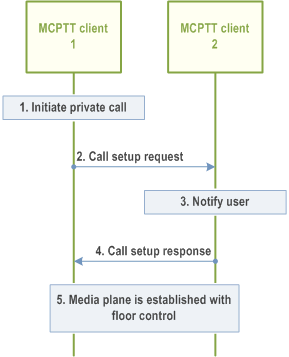
Step 1.
The MCPTT user at MCPTT client 1 would like to initiate a private call to the MCPTT user at MCPTT client 2.
Step 2.
The MCPTT client 1 sends a call setup request towards the MCPTT client 2. The call setup request contains an SDP offer, an automatic commencement mode indication, and an element that indicates that MCPTT client 1 is requesting the floor. If the private call request requests the floor it may include location information.
Step 3.
The MCPTT client 2 notifies the MCPTT user about the incoming private call.
Step 4.
The receiving MCPTT client 2 accepts the private call automatically, and a call setup response indicating the successful call establishment is sent to MCPTT client 1. If MCPTT client 2 rejected the incoming call, the MCPTT client 2 sends a call setup response indicating the failure reason to the MCPTT client 1.
Step 5.
The MCPTT client 1 and the MCPTT client 2 have successfully established the media plane for communication with floor control and the MCPTT client 1 is automatically granted the floor.
10.7.3.4 Private call setup in manual commencement mode p. 131
The procedure focuses on the case where an MCPTT user is initiating an MCPTT private call for communicating with another MCPTT user when off-network using a manual commencement mode.
Procedures in Figure 10.7.3.4-1 are the basic signalling procedures for the MCPTT client initiating establishment of an off-network MCPTT private call with the chosen MCPTT user.
Pre-conditions:
- MCPTT user profile used for off-network operation mode is pre-provisioned in the MCPTT UEs.
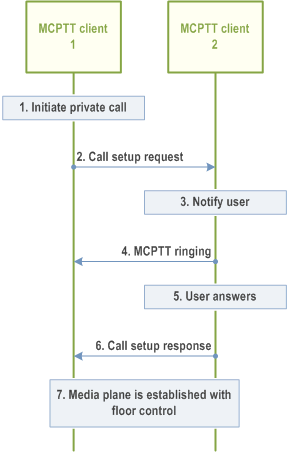
Step 1.
The MCPTT user at MCPTT client 1 would like to initiate an MCPTT private call to the MCPTT user at MCPTT client 2.
Step 2.
The MCPTT client 1 sends a call setup request towards the MCPTT client 2. The MCPTT private call setup request contains an SDP offer, a manual commencement mode indication, and an element that indicates that MCPTT client 1 is requesting the floor. If the private call request requests the floor it may include location information.
Step 3.
The receiving MCPTT client 2 notifies the MCPTT user about the incoming private call.
Step 4.
The MCPTT client 2 sends MCPTT ringing message to the MCPTT client 1.
Step 5.
The MCPTT user at the MCPTT client 2 has accepted the call using manual commencement mode (i.e., has taken some action to accept via the user interface). The MCPTT user may also reject or fail to answer the incoming call.
Step 6.
The MCPTT client 2 sends a call setup response indicating the successful call establishment to MCPTT client 1. If the MCPTT client 2 rejected the call or the MCPTT user 2 rejected or failed to answer the incoming call, the MCPTT client 2 sends a call setup response indicating the failure reason to the MCPTT client 1.
Step 7.
The MCPTT client 1 and the MCPTT client 2 have successfully established the media plane for communication with floor control and the MCPTT client 1 is automatically granted the floor.
10.7.3.5 Private call release p. 132
The procedure focuses on the case where an MCPTT client is requesting to release an ongoing MCPTT private call whether the call was established using either of the two commencement modes (manual or automatic), as described in subclause 10.7.3.3 and subclause 10.7.3.4. Either MCPTT client can initiate the call release procedure.
Procedures in Figure 10.7.3.5-1 are the basic signalling control plane procedures for an MCPTT client initiating the release of an ongoing off-network MCPTT private call.
Pre-conditions:
- Two MCPTT users are currently engaged in an off-network MCPTT private call.
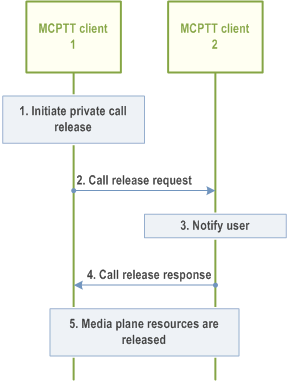
Step 1.
The MCPTT user at MCPTT client 1 would like to initiate an MCPTT private call release to the MCPTT user at MCPTT client 2.
Step 2.
The MCPTT client 1 sends a call release request towards the MCPTT client 2.
Step 3.
The MCPTT client 2 notifies the MCPTT user about the private call release.
Step 4.
The MCPTT client 2 sends a call release response indicating the successful call release to MCPTT client 1.
Step 5.
The MCPTT client 1 and the MCPTT client 2 release all associated media plane resources.
10.7.3.6 MCPTT emergency private call p. 133
The off-network emergency private call is a special case of off-network private call as defined in subclause 10.7.3. The following are modifications to the aforementioned subclause to support MCPTT private calls:
- The call setup contains an indication that the MCPTT private call is to be an MCPTT emergency private call,
- the bearers of both MCPTT private call participants are given MCPTT emergency priority prior to media transfer,
- either participant in an MCPTT private call may upgrade the call to the MCPTT emergency state during the call by sending an MCPTT upgrade private emergency request,
- placing an MCPTT emergency private call places the MCPTT client in the MCPTT emergency state,
- the bearer priority of each participant is restored to the priority as it was prior to the MCPTT emergency private call initiation, when the call ends or when the MCPTT emergency priority is cancelled
- an authorized user or the originator of the call may cancel the MCPTT emergency priority of the call by sending an MCPTT cancel private emergency request and
- the MCPTT emergency priority of the MCPTT private call may be cancelled when criteria established by the MCPTT Administrator are met (e.g., timeout).
10.7.4 MCPTT private call call back request p. 134
10.7.4.1 Information flows for MCPTT private call call back request p. 134
10.7.4.1.1 MCPTT private call call back request p. 134
Table 10.7.4.1.1-1 describes the information flow MCPTT private call call-back request from the MCPTT client to the MCPTT server and from the MCPTT server to the MCPTT client.
| Information element | Status | Description |
|---|---|---|
| MCPTT ID | M | The MCPTT ID of the calling party. |
| MCPTT ID | M | The MCPTT ID of the called party. |
| Urgency indication | M | This element indicates the urgency (i.e., low, normal, high) of the call-back request. |
10.7.4.1.2 MCPTT private call call back response p. 134
Table 10.7.4.1.2-1 describes the information flow MCPTT private call call-back response from the MCPTT client to the MCPTT server and from the MCPTT server to the MCPTT client.
| Information element | Status | Description |
|---|---|---|
| MCPTT ID | M | The MCPTT ID of the calling party. |
| MCPTT ID | M | The MCPTT ID of the called party. |
| Result | M | Result of the MCPTT call-back request - success or fail. |
10.7.4.1.3 MCPTT private call call back cancel request p. 134
Table 10.7.4.1.3-1 describes the information flow MCPTT private call call-back cancel request from the MCPTT client to the MCPTT server and from the MCPTT server to the MCPTT client.
| Information element | Status | Description |
|---|---|---|
| MCPTT ID | M | The MCPTT ID of the calling party. |
| MCPTT ID | M | The MCPTT ID of the called party. |
10.7.4.1.4 MCPTT private call call back cancel response p. 134
Table 10.7.4.1.4-1 describes the information flow MCPTT private call call-back cancel response from the MCPTT client to the MCPTT server and from the MCPTT server to the MCPTT client.
| Information element | Status | Description |
|---|---|---|
| MCPTT ID | M | The MCPTT ID of the calling party. |
| MCPTT ID | M | The MCPTT ID of the called party. |
| Result | M | Result of the MCPTT private call call-back cancel request - success or fail. |
10.7.4.2 MCPTT private call call back request within one MCPTT system p. 135
The MCPTT private call call-back request procedure includes the initial MCPTT private call call-back request from the MCPTT user and the indication to the receiving MCPTT user of the who called, the time when the call request was made, and the urgency indication.
Procedures in Figure 10.7.4.2-1 show the signalling control plane procedures for the MCPTT client initiating an MCPTT private call call-back request with the chosen MCPTT user.
Pre-conditions:
- MCPTT user 1 is the current user at MCPTT client 1 and MCPTT user 2 is the current user at MCPTT client 2;
- MCPTT client 1 and MCPTT client 2 are registered for MCPTT service.
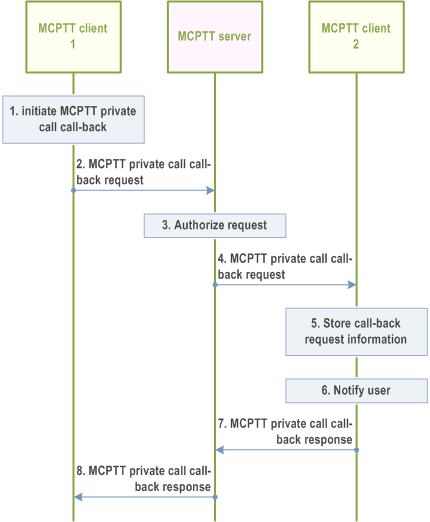
Step 1.
MCPTT user on MCPTT client 1 initiates an MCPTT private call call-back request to the MCPTT user of MCPTT client 2.
Step 2.
MCPTT client 1 sends an MCPTT private call call-back request towards the MCPTT server.
Step 3.
MCPTT server checks whether the MCPTT user 1 at MCPTT client 1 is authorized to initiate the MCPTT private call call-back request.
Step 4.
If authorized, MCPTT server sends the corresponding MCPTT private call call-back request towards the MCPTT client 2.
Step 5.
The receiving MCPTT client 2 stores the MCPTT user who initiated the MCPTT private call call-back request, the time the MCPTT private call call-back request was received, and the urgency indication for the MCPTT private call call-back request.
Step 6.
The MCPTT client 2 notifies the MCPTT user 2 that there is an MCPTT private call call-back request awaiting his attention.
Step 7.
The receiving MCPTT client 2 sends an MCPTT private call call-back response to the MCPTT server.
Step 8.
Upon receiving the MCPTT private call call-back response from MCPTT client 2, the MCPTT server informs the MCPTT client 1 about successful call-back request.
10.7.4.3 MCPTT private call call back cancel request within one MCPTT system p. 136
Once an MCPTT private call call-back request has been successfully made and before the receiving MCPTT user has made an MCPTT private call to the calling MCPTT user, the calling MCPTT user may cancel the outstanding MCPTT private call request.
Procedures in Figure 10.7.4.3-1 show the signalling control plane procedures for the MCPTT client initiating an MCPTT private call call-back cancel request with the chosen MCPTT user.
Pre-conditions:
- A previously successfully made MCPTT private call call-back request from MCPTT client 1 to MCPTT client 2.

Step 1.
MCPTT user on MCPTT client 1 wants to cancel a previously created MCPTT private call call-back request to the MCPTT user 2 of MCPTT client 2.
Step 2.
MCPTT client 1 sends an MCPTT private call call-back cancel request towards the MCPTT server.
Step 3.
MCPTT server checks whether the MCPTT user 1 at MCPTT client 1 is authorized to cancel the previous MCPTT private call call-back request, if one exists.
Step 4.
If authorized, MCPTT server sends the corresponding MCPTT private call call-back cancel request towards the MCPTT client 2.
Step 5.
The receiving MCPTT client 2 removes all stored information about the previous MCPTT private call call-back request from the MCPTT user 1 on MCPTT client 1.
Step 6.
The receiving MCPTT client 2 sends an MCPTT private call call-back cancel response to the MCPTT server.
Step 7.
Upon receiving the MCPTT private call call-back cancel response from MCPTT client 2, the MCPTT server informs the MCPTT client 1 about successful call-back request cancelation.
10.7.4.4 MCPTT private call call back request fulfillment within one MCPTT system p. 137
Once an MCPTT private call call-back request has been successfully made, it is expected that the receiving MCPTT user will make an MCPTT private call to the MCPTT user who sent the MCPTT private call call-back request. The procedures for establishing the MCPTT private call between the two users is the same as an MCPTT private call (10.7.2.2.2).
Procedures in Figure 10.7.4.4-1 show the signalling control plane procedures for the MCPTT client returning an MCPTT private call to the MCPTT user who initiated the MCPTT private call call-back request.
Pre-conditions:
- A previously successfully made MCPTT private call call-back request from MCPTT client 1 to MCPTT client 2.
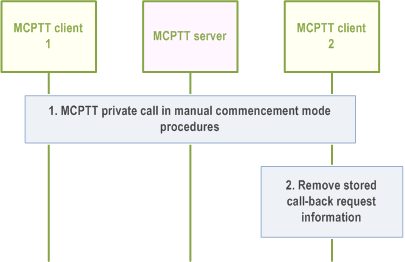
Step 1.
MCPTT user 2 on MCPTT client 2 decides to initiate an MCPTT private call based on the stored MCPTT private call call-back request to the MCPTT user 1 on MCPTT client 1 using the MCPTT private call procedures of 10.7.2.2.2.
Step 2.
Once a successful MCPTT private call has been made between the MCPTT user 1 on MCPTT client 1 and MCPTT user 2, then the MCPTT client 2 removes the stored call-back request information.